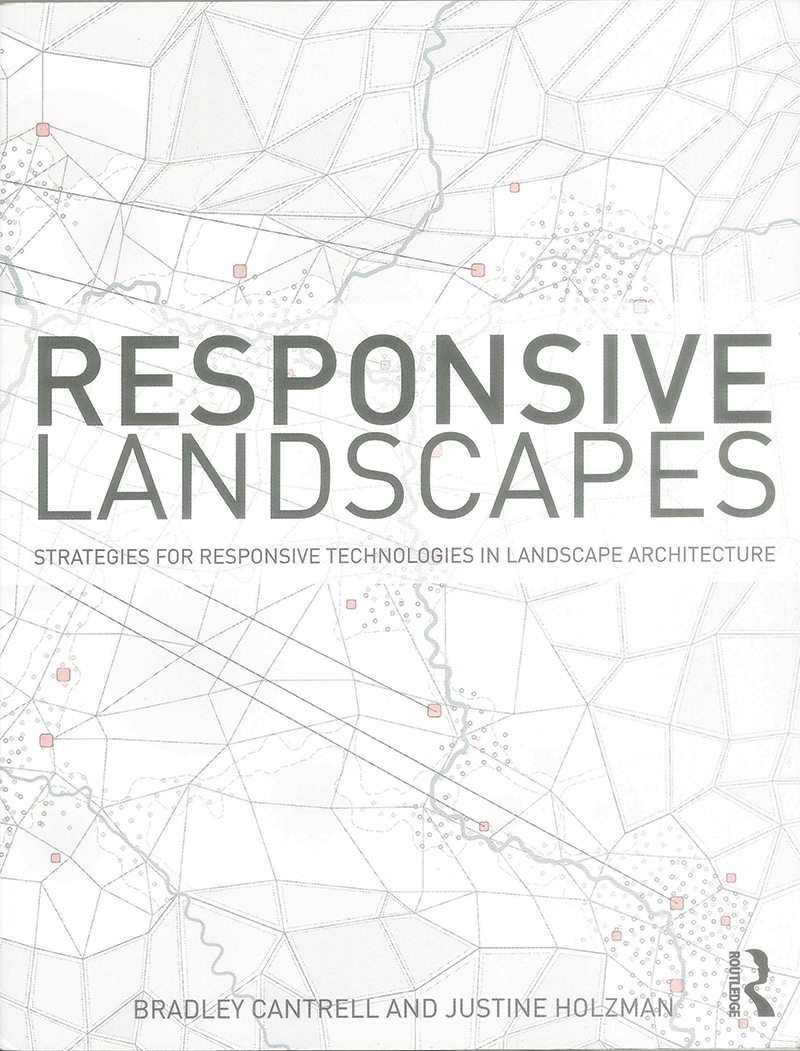Bradley Cantrell and Justine Holzman
Routledge


In contemporary designed environments, responsive technology seems to stop short at enhanced entertainment value. The “lights, cameras, action” approach to responsive environments is one in which landscapes and architecture try too hard to engage us, by lighting up or emitting sound as we approach, for example. This approach seems dulling, rather than evocative, because most landscapes already respond to us, in shifting patterns of shadows or in changing pressures of material beneath our feet, without mediation by technology. It is a welcome relief, then, that Cantrell and Holzman’s book, Responsive Landscapes, collects precedents of responsive technology in landscape that go beyond interactive entertainment value and advance the ongoing discussion in design fields of the dialectic between site and nonsite.
Many have written about the design process, production, and aesthetic potential of digital technology for landscape architecture, for example, Carl Steinitz’s A Framework for GeoDesign, Christopher Beorkem’s Material Strategies in Digital Fabrication, and Jillian Walliss and Heike Rahmann’s Landscape Architecture and Digital Technologies. Yet there are few texts about responsive technologies that change how landscapes function.
Responsive Landscapes is organized in two parts: three initial chapters discussing theories of responsive technology and landscape to establish a theory of “digital ecologies,” followed by six chapters of precedents grouped according to the role technology plays in the project. Cantrell and Holzman understand the innate responsiveness of landscapes, independent of technology. They write, “Landscapes are inherently intelligent, the biologies that comprise landscapes have their own individual behaviors, logics, and reasoning that allow these systems to evolve through connectivity and response” (41). They further suggest a future of cyborg landscapes, meaning landscapes in which responsive technology solves real dilemmas or enhances landscape systems. The authors’ evocation of a cyborg landscape is not unlike the medical theories of a brilliant and polemic figure in digital culture: Ray Kurzweil, inventor of the first optical scanner and a proponent of what he calls the “singularity.”1 Kurzweil’s singularity is the pervasive, biological fusion of human and machine within the human body. He predicts the singularity will occur within the lifetime of those reading this book review.
In the opening chapters of Responsive Landscapes, Cantrell and Holzman, like Kurzweil, predict a future with intelligent technologies embedded in living systems. As such, their vision goes beyond cyborg landscapes, which to some degree already exist, since much of the earth is manipulated by artificial vascular systems (sewers and pipelines), energy flows, and data collection via satellite. Perhaps the best example of the existing cyborg landscape in the United States is the United States Geological Survey’s stream gauge system. This system captures real-time data about water flows in US streams and describes these flows in terms of many useful parameters. But the stream gauge system is not responsive. It triggers responses by human administrators of other systems (e.g., water reservoir management), but the gauge system itself is a monitor, not an actor. Cantrell and Holzman predict a kind of ecological singularity in which technologies become actors, and like Kurzweil, they are optimistic that this singularity will offer more remedies than pitfalls.
Landscape, which is not an object and cannot be understood merely as a field of objects, has often fit poorly with the object-centric bias of most digital modeling software evolved for use in fields of engineering and architecture. Responsive Landscapes helps the design world better understand how architectural and landscape systems differ. Though a lack of clarity in writing sometimes obscures the message of the opening chapters of Responsive Landscapes, the authors introduce critical technology concepts and build an understanding of landscape as a fabric, as ecological systems, and as the postmodernist expanded field. Cantrell and Holzman’s cyborg landscape gives us a new term to conceive of a middle ground between architecture and landscape architecture, in which liminal space is pierced by, overlain with, and wired into intelligent technologies.
Perhaps because of the promise of cyborg landscapes in the introductory text, the projects featured in the section of the book titled “Elucidate” are disappointing as they tend to be architectural objects with predominantly aesthetic goals, rather than the intelligent cyborg landscapes invoked by Cantrell and Holzman. Some of the examples selected by the authors succeed more than others at deeply interpreting environmental phenomena (such as Nuage Vert by Helen Evans and Heiko Hansen), while others tend to simply aestheticize phenomena. Design precedents grouped under the later chapters “Displace,” “Ambient,” and “Modify” edge closest to intelligent cyber landscapes. One example is Smart Highway by Studio Roosegarde and Heijmans Infrastructure, a prototype for highways that reveal and adapt to changing conditions in real time.
Cantrell and Holzman drop tantalizing ideas onto the page, such as the tension between exposing and hiding ubiquitous computing in everyday life,2 without fully developing these ideas or linking them to later precedents in the succeeding sections. The authors have included both built and unbuilt precedents in the book, which at times can be confusing, since all are described as though they already exist. Nonetheless, Responsive Landscapes presents compelling examples of the messy potential of responsive technology interacting with large-scale dynamic landscape systems. And within the conversation about site/nonsite, Cantrell and Holzman have formed the perfect phrase to help others understand the role that distinguishes the landscape architect from other designers, as “a curator or manipulator of processes.”
- Ray Kurzweil, The Singularity Is Near: When Humans Transcend Biology (New York: Viking Penguin Group, 2005).
- Anne Galloway, “Intimations of Everyday Life: Ubiquitous Computing and the City,” Cultural Studies 18, nos. 2/3 (March/May 2004), cited by Cantrell and Holzman.
How to Cite this Article: Kingery-Page, Katie. Review of Responsive Landscapes: Strategies for Responsive Technologies in Landscape Architecture, by Bradley Cantrell and Justine Holzman. JAE Online. July 31, 2016. http://www.jaeonline.org/articles/reviews-books/responsive-landscapes-strategies-responsive-technologies-landscape#/.






